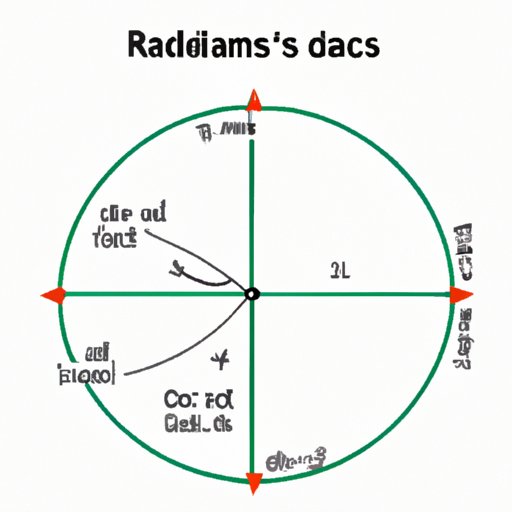Introduction
When it comes to math and science, angles are an essential part of understanding concepts such as trigonometry, calculus, and physics. However, different systems of measuring angles can make calculations more complicated. One such difference is between radians and degrees, and knowing how to convert between them is an important skill to have.
In this guide, we’ll take a look at the basics of converting radians to degrees, including step-by-step instructions and common mistakes to avoid.
A Beginner’s Guide to Converting Radians to Degrees
Before we dive into the details of converting radians to degrees, it’s important to understand what radians and degrees are, and why we need to convert between them.
Simply put, radians and degrees are two different ways of measuring angles. Degrees are the most common way of measuring angles, with a full circle having 360 degrees. On the other hand, radians measure angles based on the radius of a circle, with a full circle having an angle of 2π radians.
So why do we need to convert between them? The answer is simple: some math and science problems require the use of radians while others use degrees. Being able to convert between the two makes problem-solving simpler and more efficient.
To convert radians to degrees, we use a formula:
Step-by-Step Instructions: Converting Radians to Degrees
To convert radians to degrees, you can use the following formula:
degrees = radians x (180/π)
Let’s take an example of a circle with a radius of 5 units and an arc measuring 2π/3 radians. To convert this to degrees:
degrees = (2π/3) x (180/π) = 120°
Therefore, an arc of 2π/3 radians in a circle with a radius of 5 units corresponds to an angle of 120 degrees.
The Math Behind Radians and Degrees: Converting Between Them
While the formula for converting radians to degrees is simple enough to use, understanding the mathematical relationship between radians and degrees can provide a deeper understanding of the concepts.
The history of radians and degrees goes back to the ancient Greeks, who used the sexagesimal (base-60) system for measuring angles. The concept of radians was developed later by mathematicians in the 17th century, with the measure of an angle being the length of the arc along the circle’s circumference. Radians make calculations in trigonometry and calculus easier, and they are commonly used in physics.
So, why use radians instead of degrees? One reason is that many trigonometric functions and their derivatives have simpler formulas when the angles are measured in radians. Radians also have the advantage of being dimensionless, meaning they don’t need units, which can simplify calculations and make them more efficient. However, degrees are more intuitive and easier to understand for many people.
Rad-to-Deg: A Quick and Easy Conversion Method
While the formula for converting radians to degrees works well, a quick and easy method for conversion is to use the “rad-to-deg” method. This simple method involves multiplying the radian value by 180 and dividing by π.
To use this method, let’s take the same example as before: an arc measuring 2π/3 radians in a circle with a radius of 5 units. To convert this to degrees using “rad-to-deg”:
degrees = (2π/3) x (180/π) = 120°
As you can see, the “rad-to-deg” method provides the same result as the formula for converting radians to degrees. However, this method is quicker and easier to use for simple conversions.
Breaking It Down: How to Convert Radians to Degrees
While converting radians to degrees may seem like a simple task, there are some common mistakes that people make when doing so. Here are some tips and tricks to help you avoid these mistakes:
- Be careful to use the correct formula or method when converting radians to degrees.
- Remember to convert radians to degrees, not the other way around.
- Make sure that you use the correct value for π, which is approximately 3.14159.
- Double-check your calculations to avoid errors and mistakes.
Mastering Conversion: Radians to Degrees Made Simple
Converting radians to degrees is a relatively simple process, but it can take some practice to master. Here’s a review of the steps:
- Determine the value in radians that you want to convert
- Multiply by 180 and divide by π
- Check your work and make sure that your answer makes sense
To become proficient at converting radians to degrees, practice is key. Look for opportunities to use this formula in math and science problems, or create your own practice problems and work through them.
Unlocking the Mystery: Understanding Radians and Degrees through Conversion
Understanding radians and degrees isn’t just important for math and science. These concepts also have real-life applications in fields such as architecture, engineering, and navigation.
For example, architects need to understand angles to design buildings with stable foundations and correct angles of elevation. Engineers use angles extensively in designing machines and structures, while navigators rely on angles and trigonometry to determine their location and course.
If you’re interested in learning more about radians and degrees, check out some of the following resources:
- Khan Academy’s Trigonometry Course
- MIT’s OpenCourseWare Calculus Course
- Wolfram Alpha’s Angle Conversion Tool
Conclusion
Converting radians to degrees doesn’t have to be a mystery. With the right formula and a little bit of practice, anyone can become proficient at this skill. Remember to use the correct formula or method, double-check your work, and never be afraid to ask for help if you need it.
With these tips and tricks in mind, you’ll be converting radians to degrees like a pro in no time.
